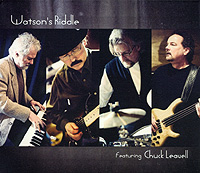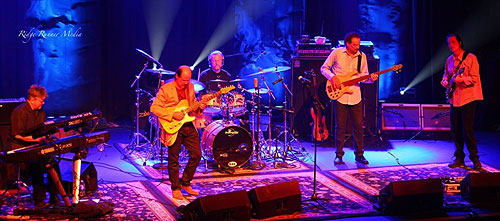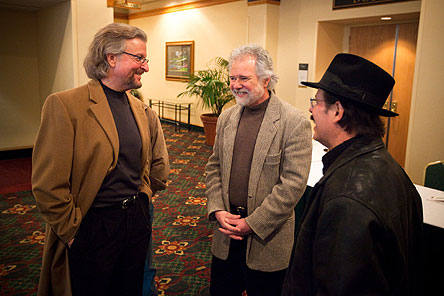 Best
known for their extensive jazz catalog, Palmetto breaks new ground
distributing the 2011 CD from South Carolina based Watson’s
Riddle. A solid studio set of new music featuring like-minded
superstar players—including guitar ace Steve Watson, Marshall
Tucker drummer Paul T. Riddle, bass player Tim Lawter and
keyboard session legend Chuck Leavell—the Watson’s
Riddle sound is completely modern American instrumental fusion. With
all songs written by guitarist Watson, the sound is full bodied and
tastefully echoes both the fusion instrumental and smooth jazz genres.
Paul Riddle describes the sound as being “melodic freak”,
while there’s truly something positive to be said about this
CD, that so expertly combines all manners of instrumental jazz, R&B
and pop. A legend of the Allman Brothers, the Stones and Sea Level,
Chuck Leavell’s piano and keyboard work truly enhances the Watson’s
Riddle album which overall should hold immense sonic appeal over fans
of guitar aces such as Pat Metheny, Lee Ritenour and Larry Carlton.
www.WatsonsRiddle.com
Best
known for their extensive jazz catalog, Palmetto breaks new ground
distributing the 2011 CD from South Carolina based Watson’s
Riddle. A solid studio set of new music featuring like-minded
superstar players—including guitar ace Steve Watson, Marshall
Tucker drummer Paul T. Riddle, bass player Tim Lawter and
keyboard session legend Chuck Leavell—the Watson’s
Riddle sound is completely modern American instrumental fusion. With
all songs written by guitarist Watson, the sound is full bodied and
tastefully echoes both the fusion instrumental and smooth jazz genres.
Paul Riddle describes the sound as being “melodic freak”,
while there’s truly something positive to be said about this
CD, that so expertly combines all manners of instrumental jazz, R&B
and pop. A legend of the Allman Brothers, the Stones and Sea Level,
Chuck Leavell’s piano and keyboard work truly enhances the Watson’s
Riddle album which overall should hold immense sonic appeal over fans
of guitar aces such as Pat Metheny, Lee Ritenour and Larry Carlton.
www.WatsonsRiddle.com
mwe3.com presents an interview with
STEVE WATSON of Watson’s Riddle
mwe3: Listening to the Watson’s Riddle CD, I was thinking back
on Duane and Dicky from the Allman Brothers, Steve Morse and then
I finally got around to discovering your pretty extensive resume over
the past 3 or 4 decades. What is it about the Southern United States
that produces such great guitar players?
 SW: I
grew up listening to Southern R&B and the blues, especially the
music of Stax Records—Otis Redding, Sam and Dave, Rufus and Carla
Thomas, William Bell. Stax R&B was not as popular in other areas
of the country as it was in the south. That, I feel is the major difference
between Southern guitarists and the rest of the country. I got into
jazz a little later. Duane Allman worked in Muscle Shoals as a session
player before he started the Allman Brothers Band. He had been playing
on Aretha Franklin records. The blues, R&B and jazz influences
enabled him to bring such an original voice to the new Southern music.
In addition, country music is an influence because of its popularity
in the area.
SW: I
grew up listening to Southern R&B and the blues, especially the
music of Stax Records—Otis Redding, Sam and Dave, Rufus and Carla
Thomas, William Bell. Stax R&B was not as popular in other areas
of the country as it was in the south. That, I feel is the major difference
between Southern guitarists and the rest of the country. I got into
jazz a little later. Duane Allman worked in Muscle Shoals as a session
player before he started the Allman Brothers Band. He had been playing
on Aretha Franklin records. The blues, R&B and jazz influences
enabled him to bring such an original voice to the new Southern music.
In addition, country music is an influence because of its popularity
in the area.
mwe3: Can you give a little history as to how the Watson’s Riddle
CD came about? How’d you get that much talent into one room and
how’d you guys meet? The CD sounds like a superstar recording
session.
SW: Watson’s Riddle started as a project with Dr. Douglas Appleby,
a cardiac surgeon taking guitar lessons with me. He wanted me to write
music for him to relax to. I got my friend Paul Riddle involved and
we decided to go into the studio to record the material I had written.
He brought his friend Chuck Leavell in to play piano. He also engaged
engineer Tim Lawter from his Marshall Tucker days to play bass. Tim
started playing on the tracks and the band just came together from
relationships with other musicians.
 In the beginning,
we never played in the same room at the same time. We each overdubbed
our parts. By the way, thanks for the complement on the sound. We
recorded at Mill Street Studios in Inman, SC. (Spartanburg) A lot
of the sound can be attributed to Rusty Milner who is our lead engineer
and mixer. He mastered the CD and serves as the 2nd guitarist in our
live show. He is a wonderful player and also from The Marshall Tucker
Band.
In the beginning,
we never played in the same room at the same time. We each overdubbed
our parts. By the way, thanks for the complement on the sound. We
recorded at Mill Street Studios in Inman, SC. (Spartanburg) A lot
of the sound can be attributed to Rusty Milner who is our lead engineer
and mixer. He mastered the CD and serves as the 2nd guitarist in our
live show. He is a wonderful player and also from The Marshall Tucker
Band.
Spartanburg has a rich musical history with The Marshall Tucker Band
as well as Hank Garland, the great guitarist that the Gibson Byrdland
is named after. Joe Bennett and The Sparkletones who had a hit record
in the early 60’s are also from there.
mwe3: What is it like working with Chuck Leavell who is sometimes
referred to as the sixth member of The Rolling Stones? It’s interesting
Watson’s Riddle also features drummer Paul Riddle, founding drummer
of The Marshall Tucker Band, how did you meet those great players?
SW: Chuck is a wonderful person and pianist. He is one of the most
unique players around. He is a not only a master soloist but also
a master of rhythm piano. He makes all of the tracks feel great. He’s
a Southern boy who also grew up listening to the music I mentioned
earlier but he has the New Orleans piano history in his playing as
well. I know of no one else who plays like him. He was playing like
this as a teenager with The Allman Brothers.
 Paul and
I met when I moved to Greenville, South Carolina in 1990. We had wanted
to do something like this for a long time. It finally worked out with
the help of Dr. Appleby. I met Chuck through Paul, but I had originally
met him when I opened a show for his band Sea Level. That was in 1979
when I was playing with The Bruce Hornsby Band.
Paul and
I met when I moved to Greenville, South Carolina in 1990. We had wanted
to do something like this for a long time. It finally worked out with
the help of Dr. Appleby. I met Chuck through Paul, but I had originally
met him when I opened a show for his band Sea Level. That was in 1979
when I was playing with The Bruce Hornsby Band.
mwe3: How did you come to study the guitar and can you recall what
it was like studying with Joe Diorio and how did your early studies
lead you to your guitar teaching career and then soundtrack work?
SW: My mother started my guitar lessons in the second grade from the
great Charles Wood in Greenville, SC. Charlie was a veteran of the
New York jazz scene. During my high school days he introduced me to
the music of the American Songbook. I began playing in R&B bands
around the region on the weekends when I was in 10th grade.
When I went to The University of Miami for a masters degree I had
the opportunity to study with Joe Diorio. He was fantastic and is
one of the most under-recognized jazz guitarists in history. He is
a brilliant player, teacher and painter. He and I ended up in L.A.
in the 80’s and we both taught at The University of Southern
California in the guitar department. I moved to L.A. with Bruce Hornsby
in 1980 and I met Mike Post who had a lot of TV and session work at
that time. He started using me on his sessions and that led to a lot
of other work including teaching at USC. Richard Smith and Andrew
York were students there at that time.
 mwe3: I
read you played guitar for Dolly Parton, Bob Hope and The Pointer
Sisters? What are some of your favorite studio session work, favorite
commercials and favorite soundtracks?
mwe3: I
read you played guitar for Dolly Parton, Bob Hope and The Pointer
Sisters? What are some of your favorite studio session work, favorite
commercials and favorite soundtracks?
SW: I was very lucky during my 10 years in L.A. I had the opportunity
to work thousands of sessions and was able to make friends with some
of the greatest musicians on the planet. At one point, I was working
eight network one hour TV shows every week—Magnum PI, The A-Team,
Hill Street Blues, The Greatest American Hero, Hardcastle and McCormick,
Quantum Leap, etc. My favorite sessions were sitting next to the great
bass player, Leland Sklar. He and I played on hundreds of dates together
and also played live shows with Mike Post.
Having headphones on and hearing Dolly Parton sing with you is definitely
one of the high points of my L.A. career. She is an amazing artist
and it was a pleasure to work with her for eight months in 1988 on
her TV show. I thank my friend Velton Ray Bunch for that gig. He is
a Carolina boy from North Carolina whom I connected with in L.A. He
is a great writer and producer that the general public is unaware
of. My Pointer Sisters and Eddie Rabbit gig came from Ray.
 mwe3: Can
you tell us something about the guitars you feature on the new Watson’s
Riddle CD? Do you have a signature guitar planned and do you follow
the current developments in the guitar world? Who are some of your
favorite current guitarists?
mwe3: Can
you tell us something about the guitars you feature on the new Watson’s
Riddle CD? Do you have a signature guitar planned and do you follow
the current developments in the guitar world? Who are some of your
favorite current guitarists?
SW: I love Tom Anderson guitars. Our record is played on my Anderson
Hollow-T Classic and my Classic Strat. I just started playing their
new Bulldog and it’s amazing. P-90’s with no hum are an
amazing sound. Their guitars play like butter, tune up and stay in
tune. I don’t believe there are better guitars anywhere. You
don’t have to baby them—they just work for you.
I am a gear junkie. I am constantly looking at new guitars, amps,
pedals, effects, and software. I am always interested in the gear
my favorite guitarists are using. Speaking of favorite guitarists
past and present, I’ll list a few here—Wes Montgomery, Jim
Hall, Pat Metheny, John Scofield, Oz Noy, Jonathan Kriesberg, Lage
Lund, Robben Ford, Larry Carlton and Chuck Loeb are among my favorites.
mwe3: What are your current and future plans with WatsonWood Music
and can you say something about your teaching at Furman University?
 SW: I own
a private teaching school in Greenville, S.C., called WatsonWood Music.
We teach students from beginners to professionals. There are 4 guitar
teachers and a drum instructor. My high school jazz guitar program
is at a school called The Fine Arts Center. It is housed in a world-class
facility with 400 students. I teach 45 young jazz musicians five days
a week. It is a total pleasure to interact with these talented young
people. Fifty percent of them go on to some of the greatest jazz universities
and conservatories in the nation. I also teach private lessons, combos
and jazz history at the very prestigious Furman University. The students
are very bright and motivated. A great tenor saxophonist Matt Olson
runs the jazz program and he played on our record.
SW: I own
a private teaching school in Greenville, S.C., called WatsonWood Music.
We teach students from beginners to professionals. There are 4 guitar
teachers and a drum instructor. My high school jazz guitar program
is at a school called The Fine Arts Center. It is housed in a world-class
facility with 400 students. I teach 45 young jazz musicians five days
a week. It is a total pleasure to interact with these talented young
people. Fifty percent of them go on to some of the greatest jazz universities
and conservatories in the nation. I also teach private lessons, combos
and jazz history at the very prestigious Furman University. The students
are very bright and motivated. A great tenor saxophonist Matt Olson
runs the jazz program and he played on our record.
mwe3: What are your upcoming plans with Watson’s Riddle in 2012?
Are you planning to tour or follow up with another release, CD or
DVD, at some point?
SW: Watson’s Riddle is currently working on a new CD. It will
be funkier and a little more “in your face” than our first
CD. It will reflect more of my R&B and L.A. guitar influences.
All of the songs have been written and we are trying to decide on
which ones best suit our current direction. We have a live show filmed
in HD that we are thinking of releasing on a DVD. Two of the tracks
are currently on You Tube.
 Paul
and I are a great team when it comes to being honest about what is
good. No prisoners between us. We only speak the truth. We are working
on as many live shows as we can play in a concert setting for 2012.
Paul
and I are a great team when it comes to being honest about what is
good. No prisoners between us. We only speak the truth. We are working
on as many live shows as we can play in a concert setting for 2012.
Thanks to Steve Watson @ www.WatsonsRiddle.com



